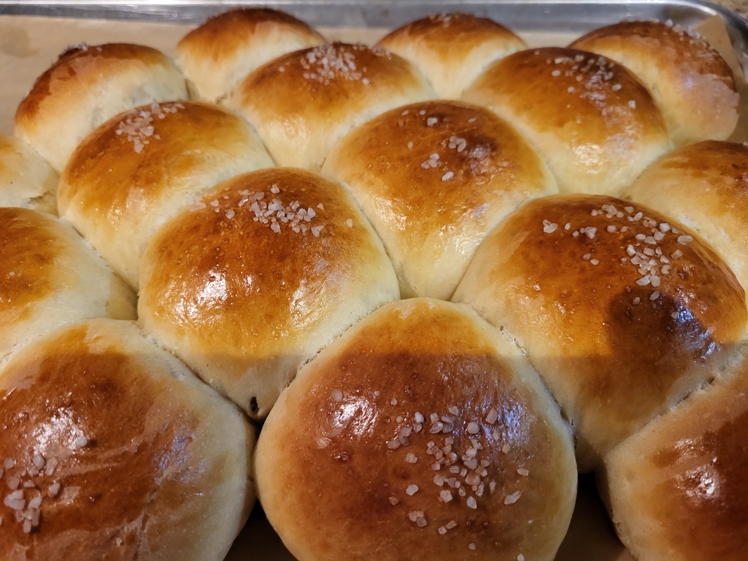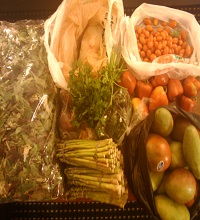Fixin's for People Who Like Food
 Homemade Hawaiian Rolls
October 15th, 2025
Homemade Hawaiian Rolls
October 15th, 2025
This Recipe creates 14 servings
Prep Time: 03 hours
Cook Time: 30 minutes

Hawai'ian bread is a sweetened bread, much like a brioche, that is commonly found in Hawai'ian cuisine. There are countless variations of Hawaiian Bread recipes, often handed down from your "Kupuna Wahine" (Grandmother). Hawaiian Bread is often served as a large single round loaf and then cut into slices, or served as small rolls. This recipe creates the individual, single serving rolls. Due to the high amount of acids in the pineapple juice, the yeast will require a longer rise time. With a little patience, you can end up with the perfect container for a ham, cheese, and grilled pineapple slider. In order to produce a soft fluffy crumb, this recipe requires dough that is very sticky and difficult to handle. Working additional flour into the dough will effect the quality of your finished bread. In order to prevent the dough from sticking without adding more flour, use frequently applied olive oil or water on your hands while working with the dough.
Ingredients:
==========
Dry Ingredients
4 Cups (500 Grams) All-Purpose Flour
1.5 Tablespoon (7 Grams) Yeast
1 Cup (7.1 Ounces / 200 Grams) Sugar
1/2 Teaspoon Salt
1/2 Teaspoon Ground Ginger
Wet Ingredients
3/4 Cup (6 Ounces) Water
3/4 Cup (6 Ounces) Canned Pineapple Juice (NOT Fresh Pineapple Juice)
2 Eggs, warmed to room temperature
1/2 Cup Olive Oil
1 Teaspoon Vanilla
Egg Wash
1 Egg
1 Tablespoon Water
Shredded Coconut (optional)
Directions:
=========
Mix Ingredients
Add all the Dry Ingredients into the mixer bowl and stir until fully integrated.
Mix together the Water and the Pineapple Juice. Use the microwave to heat the Water/Juice mixture until it reaches 120° F.
In a separate bowl, whisk together the Olive Oil, the Eggs, and the Vanilla until fully mixed.
Whisk the Water/Juice mixture in with the Oil/Egg/Vanilla mixture until fully integrated.
Add the Wet Ingredients into the Dry Ingredients. Mix the Dough together until fully integrated.
Run the mixer on medium for 5 minutes or knead vigorously with a spatula for 10 minutes.
This will produce a very wet, very sticky "Slack Dough" that is too loose to hold a firm shape.
Rest the Dough
Cover the Dough and rise for 2 hours in a warm place. The Dough should double in size.
Form the Rolls
After 2 hours:
Cover a large sheetpan with parchment paper.
Oil your hands with a few drops of Olive Oil and punch down the Dough.
Separate the Dough into 14 ?? equal Rolls, weighing about 65 Grams each.
Use your hands and shape each Roll into a round Dough Ball.
Arrange each Roll on the sheetpan so that they are almost touching each other.
Re-oil your hands frequently, as needed, to prevent the Dough from sticking to your hands while you create each Dough Ball.
Rest the Dough (Again)
Cover the Rolls with a clean tea towel and rest the Dough for another 1 hour.
Finish each Roll
After 1 more hour...
Preheat the oven to 325° F.
Whisk together the Egg Wash and brush it on the top of each Roll.
Optionally, sprinkle a pinch of Sesame Seeds or Shredded Coconut on the top of each Roll.
Bake
Bake for 26 minutes, until the tops are golden brown.
The internal temperature should reach 190° F.
Immediately cover with a clean tea towel and cool for about 10 minutes. This will trap moisture as the Rolls cool, resulting in a softer crust.


 Homemade Hawaiian Rolls
October 15th, 2025
Homemade Hawaiian Rolls
October 15th, 2025
